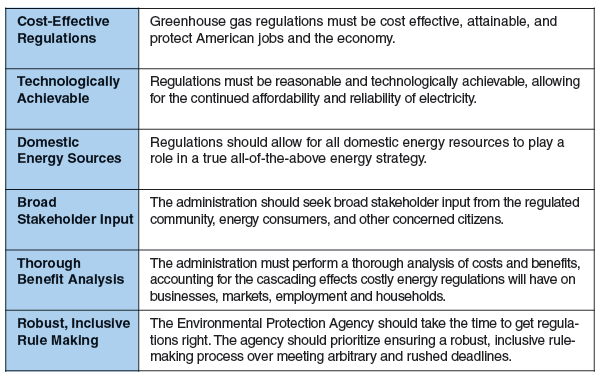
Industry Advocacy
Coalition Seeks Reasonable Regulation
By Gregory DL Morris, Special Correspondent
WASHINGTON–Important energy policy and climate change legislation likely will be debated this summer in Washington and in statehouses across the country, and the Partnership for a Better Energy Future (PBEF) came into being earlier this year to prepare energy companies and other stakeholders to participate.
The partnership is an association of key energy-industry and downstream trade groups, including the Independent Petroleum Association of America, the American Petroleum Institute, and the American Fuel & Petrochemical Manufacturers. More than 100 member organizations have adopted PBEF’s six core principles (see Table 1).
The National Association of Manufacturers and the U.S. Chamber of Commerce were the founding associations in the PBEF, but Vice President of Communications and Public Affairs Jeff Eshelman says IPAA was present at the creation and participated with those two groups at the Jan. 30 formal launch.
In the statement announcing it had joined the partnership, IPAA noted it had done so along with, “stakeholders from nearly every sector of the U.S. economy in a coalition that will advocate for a common-sense approach to greenhouse gas policies to ensure the continued availability of affordable and reliable energy for American families and businesses.”
IPAA further noted that the partnership consisted of “groups representing consumers and businesses from sectors such as manufacturing, agriculture, refining and mining, (and) will serve as the leading voice in support of a unified strategy and message in response to the Obama administration’s GHG regulatory agenda.”
A Positive Message
From the start, the partnership has stressed a positive message, rather than just trying to block initiatives with which it disagrees. IPAA endorsed that model of positive engagement. “In addition to advocating reasonable reforms to the current regulatory approach, the partnership will work to educate the public, and local, state and national policymakers on the impact that poorly crafted GHG regulations will have on the availability of affordable and reliable energy,” it says in its statement.
NAM and the U.S. Chamber’s Institute for 21st Century Energy will serve as co-chairs of the PBEF. “The administration’s suite of greenhouse gas regulations will have a profound impact on every aspect of our nation’s economy, especially on America’s job creators,” said Karen Harbert, the institute’s president and chief executive officer, at the PBEF launch in Washington.
“While each of the many organizations that are part of this new partnership will continue to work with their own grass-roots networks and memberships, this broad coalition will enable us to amplify and unify our efforts here in Washington and across the country,” Harbert declared.
While North America’s unconventional oil and gas bonanza has been pioneered by independent producers, U.S. majors have increased their participation significantly. API President and CEO Jack Gerard emphasized the nation’s energy renaissance in announcing API’s participation in PBEF.
He said, “This partnership seeks to highlight how America’s energy revolution not only is creating jobs, but also is lowering emissions, thanks to private investment. The president recognizes the important role natural gas has played in reducing carbon dioxide levels to near 20-year lows. Ironically, with his plans to raise taxes and add unnecessary regulations, President Obama runs the risk of unwinding the significant environmental benefits from natural gas, threatening our economic recovery, and dampening our ability to create millions of high-paying American jobs.”
Downstream Upbeat
To remain competitive in a global economy, manufacturers and all consumers of energy need an all-of-the-above energy strategy to ensure access to affordable and reliable energy, says NAM President and CEO Jay Timmons. “Unfortunately, this administration seems to believe the only way to reduce GHG emissions is to eliminate fossil fuels from our economy,” he states. “Manufacturers believe we can use these and other fuels while reducing our emissions. We must convince the administration to make better choices as it begins to regulate GHGs. Through this coalition, we hope to do so.”
Driving home the point, AFPM President Charles T. Drevna notes that President Obama himself has stated publicly that domestic GHG emissions are at a 20-year low. But, Drevna adds, “Despite this reality, (the president) seems intent on moving forward with extreme, overly costly and possibly unachievable regulations that threaten the manufacturing renaissance. Even the Environmental Protection Agency has acknowledged that unilateral U.S. action would not do anything to reduce global GHG emissions. This important coalition will emphasize the need for a more common-sense regulatory approach to help ensure our energy policies do not send manufacturing jobs overseas.”
Attesting to that point, Chris Jahn, president of the Fertilizer Institute, observes, “After losing almost 50 percent of its production capacity in the last decade, the nitrogen fertilizer industry’s contribution to the economy is now growing, largely because of a stable supply of natural gas. Natural gas accounts for between 70 and 90 percent of the cost of manufacturing nitrogen fertilizer, and any policy that drives up natural gas demand puts high quality jobs in the fertilizer industry at risk.”
The fundamental understanding among PBEF members is that “we are all next,” explains Greg Bertelsen, director of energy resources policy at NAM. “The rules for future power plants have been issued already. We are expecting rules for existing power plants in June. But after that, it is likely to be oil and gas producers, then refineries and any energy-intensive manufacturing. The first regulations will set the precedent for what happens when the rules get to the next industry.”
Bertelsen emphasizes that the proposed regulations aspire too much to unproven technology. “We know the technology standards are unachievable because we represent the companies that make the systems. We know there are opportunities for innovation, but we have to be realistic about where we are in that process,” he says. “Carbon capture and sequestration is a great deal more than just a filter on the end of a pipe. It is a complex system that can cost into the millions, even billions, of dollars.”
Beyond the cost, Bertelsen comments, “Those systems need to be developed and integrated, not just bolted onto the back end of existing operations. The big point for the makers of these technologies is to allow time for them to develop. Mandating them now may result in them being developed overseas.”
It would be ironic, he muses, if the growth in domestic energy production that is driving a U.S. manufacturing renaissance ends sending some economic and technical development, along with jobs, overseas.
Hit Energy Users Twice
PBEF’s goal is to get the EPA onto a path that is more reasonable and achievable, Bertelsen says. He notes that NAM, the U.S. Chamber, and PBEF all support HR 3826, legislation sponsored by House Energy and Power Subcommittee Chairman Ed Whitfield, R-Ky., that would prohibit the EPA from setting clean air standards based on unproven technology. Senator Joe Manchin, D-W.V., has introduced a companion bill, S 1905.
“We consider these bills to be more moderate,” says Bertelsen. “They do not say EPA can’t regulate, they just put reasonable parameters on those regulations.”
Having alternate proposals is important, Bertelsen continues. “We are not just ‘saying no.’ We are not trying to stop EPA regulation. We are trying to find areas that are workable,” he says. “The message from the partnership to our members, and on behalf of our members’ members, is let us have an honest, informed conversation about what is reasonable and achievable.”
Dan Byers, senior director of policy at the U.S. Chamber, recalls that the idea for the PBEF arose more or less simultaneously among leaders in his organization and NAM after the speech President Obama gave in June 2013, outlining his broad energy and environmental plans. “It started with power plants, but it was clear that it was going on to other sources,” he relates. “The economy would get hit twice: first with regulations on energy producers, and then directly on energy users. At that point, we realized it made sense to form a broad industrial coalition.”
Internal discussions followed about what other industries were likely to climb on board, Byers goes on. “We thought, ‘OK, those guys care . . . and those guys care . . . and those guys care,” he relates. “Pretty soon, it made sense to create a coordinating group. Operationally, we think of the PBEF as a federation, sharing and distributing information among the members. We have more than 100 member organizations already, and we are still growing.”
One area of emphasis is pending and proposed regulation. “All these proposed rules have public comment periods,” Byers points out. “From what we have seen, the dockets are pretty sparse in feedback from organizations and interests that should be providing input. When organizations join the partnership, they are signing on to the six core principles. The idea is to coordinate the ideas on which we all agree and stand together to represent those principles.”
It hardly needs reiterating that GHG emissions and climate change regulations are extremely important to IPAA, reminds Eshelman. “We are not only energy producers, we are energy consumers as well,” he comments. “We already had relationships with NAM and the Chamber. Their members consume the energy produced by our members, so when they got together, it was a natural fit for us.”
Reflect Reality
Reinforcing the message from NAM and the U.S. Chamber, Eshelman reiterates that IPAA is not opposed to regulation, but is eager to be part of the debate and the process of crafting reasonable and realistic rules. “We want to help ensure any new regulations reflect the needs of our industry,” he says. “It is very important to stay ahead of regulation and legislation.”
That is exactly the point of departure for PBEF. “The first rules take aim at existing power plants, which means a lot of coal-fired units,” Eshelman notes. “But the next will be for power plants not yet built, and those more and more are gas-fired.”
He comments that from 2000 to 2010, more than 80 percent of new power-generating capacity was fueled by natural gas. “Our industry has a lot to lose if there are excessive regulations on gas-fired plants. Even if the regulations started on coal, it seems pretty clear the agenda is all fossil fuels.”
Eshelman re-emphasizes the all-of-the-above element of PBEF’s core principles, adding, “We don’t believe the government should be picking winners.”
While acknowledging that natural gas has benefited from the retreat from coal, he hastens to add, “All fuels are becoming more efficient, but we believe gas can compete, even against coal.”
IPAA’s direct involvement with PBEF from the outset means two things for member companies, Eshelman surmises. “We have 10,000 members in 33 states that we are poised to mobilize. We are going to make sure our members are involved in the process in ways such as filing comments to EPA, but also to state and local regulators and legislators,” he outlines. “Second, we can coordinate our grass-roots campaigns with those of other PBEF member organizations so they can do the most good.”
Eshelman elaborates that by its charter, IPAA can be involved only with national issues; state issues are the bailiwick of industry associations in the respective states. IPAA is starting an outreach program to those various state associations, encouraging them to join PBEF directly, Eshelman says.
“We have been doing these types of things since 1929,” he reflects. “We know how important it is for associations as well as individual companies to be directly involved. We also know the economy is growing because of energy. The United States is the number one gas producer in the world already, and within two years can be the number one oil producer as well. Regulations that add costs at the wellhead, burner tip or liquefied natural gas tanker don’t help the economy. Things are really going to start moving more quickly this spring and summer. This is all coming together just in time.”
For other great articles about exploration, drilling, completions and production, subscribe to The American Oil & Gas Reporter and bookmark www.aogr.com.














